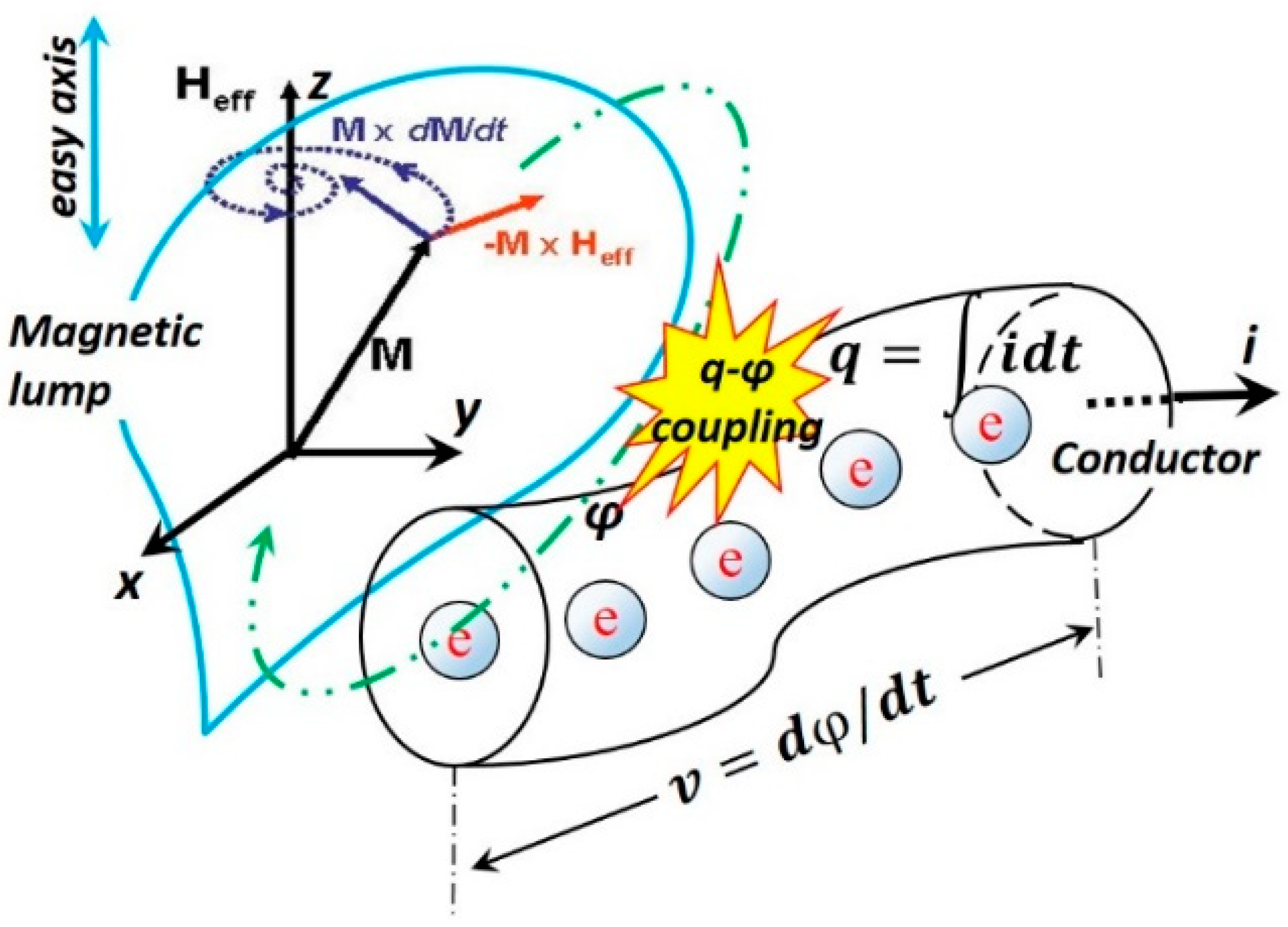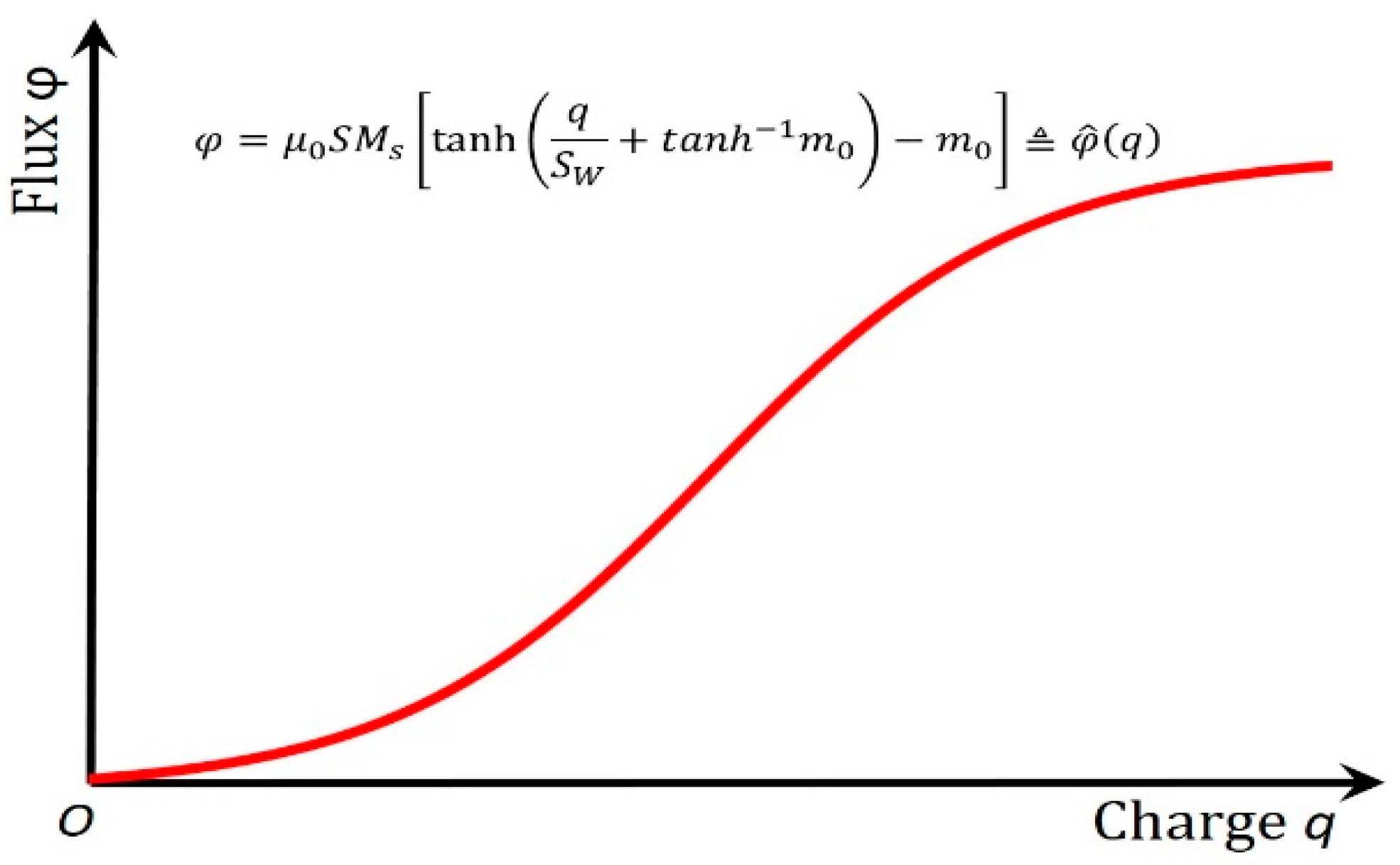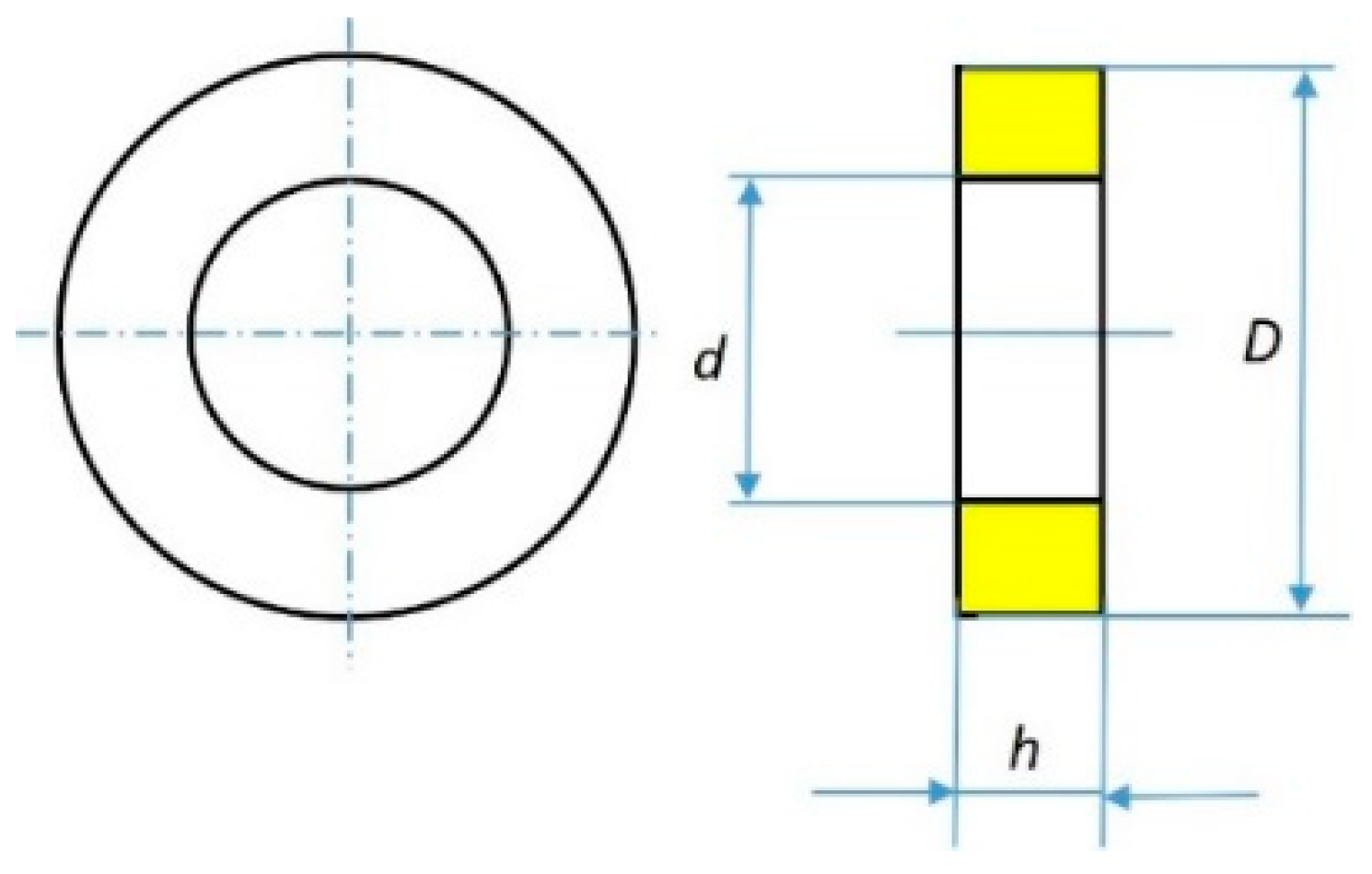Can We Still Find an Ideal Memristor?
Abstract
1. Introduction
2. Magnetic Lump with Flux–Charge Interaction
3. LLG Model of Magnetic Flux Reversal
4. Parasitic Inductance and Stepwise Memristance
5. Conclusions and Arguments
- The aforementioned memristive fingerprint hides behind a superficial inductor effect due to its inductor-like structure. It was necessary to apply a constant input current (such as a step-function or a sequence of square-wave pulses) to depress the inductor effect (). Despite the existence of parasitic inductance, the structure displays memristivity; similarly, a real-world resistor is still thought to be a resistor despite the existence of an (inevitable) parasitic inductance and/or capacitance. Most importantly, the structure exhibits that its charge–flux interaction is memristive by nature.
- The structure is bistable and dynamically sweeps a continuous range of resistances. This “dynamical continuity” results from the uniaxial magnetic anisotropy of the prototype, which contains magnetic material with only one easy axis. A fully functioning ideal memristor should have multiple or an infinite number of stable states so its static memristance can be “frozen” at any intermediate point in time.
Funding
Data Availability Statement
Conflicts of Interest
References
- Chua, L. Memristor—The Missing Circuit Element. IEEE Trans. Circuit Theory 1971, 18, 507–519. [Google Scholar] [CrossRef]
- Strukov, D.; Snider, D.; Stewart, S.; Williams, S. The missing memristor found. Nature 2008, 453, 80–83. [Google Scholar] [CrossRef]
- Williams, R.S. How we found the missing memristor. IEEE Spectr. 2008, 45, 29–35. [Google Scholar] [CrossRef]
- Chua, L. If it’s pinched it’s a memristor. Semicond. Sci. Tech. 2014, 29, 104001. [Google Scholar] [CrossRef]
- Chua, L. Resistance switching memories are memristors. Appl. Phys. A 2011, 102, 765–783. [Google Scholar] [CrossRef]
- Georgiou, P.S.; Barahona, M.; Yaliraki, S.N.; Drakakis, E.M. On memristor ideality and reciprocity. Microelectron. J. 2014, 45, 1363–1371. [Google Scholar] [CrossRef]
- Adee, S. Resistance to Memristance. IEEE Spectr. 2008, 45, 34. [Google Scholar] [CrossRef]
- Vongehr, S.; Meng, X. The missing memristor has not been found. Nat. Sci. Rep. 2015, 5, srep11657. [Google Scholar] [CrossRef]
- Sundqvist, K.M.; Ferry, D.K.; Kish, L.B. Memristor Equations: Incomplete Physics and Undefined Passivity/Activity. Fluct. Noise Lett. 2017, 16, 1771001. [Google Scholar] [CrossRef]
- Sundqvist, K.M.; Ferry, D.K.; Kish, L.B. Second Law based definition of passivity/activity of devices. Phys. Lett. A 2017, 381, 3364–3368. [Google Scholar] [CrossRef][Green Version]
- Abraham, I. The case for rejecting the memristor as a fundamental circuit element. Sci. Rep. 2018, 8, 10972. [Google Scholar] [CrossRef]
- Kim, J.; Pershin, Y.; Yin, M.; Datta, T.; Di Ventra, M. A Definitive Demonstration that Resistance-Switching Memories Are Not Memristors. Available online: http://nvmw.ucsd.edu/nvmw2022-program/nvmw2022-data/nvmw2022-paper1-final_version_your_extended_abstract.pdf (accessed on 27 June 2024).
- Landau, L.D.; Lifshitz, E.M. Theory of the dispersion of magnetic permeability in ferromagnetic bodies. Physik. Z. Sowjetunion 1935, 8, 153–169. [Google Scholar]
- Gilbert, T.L. A Lagrangian formulation of the gyromagnetic equation of the magnetic field. Phys. Rev. 1955, 100, 1243. [Google Scholar]
- Menyuk, N.; Goodenough, J. Magnetic materials for digital computer components. I. A theory of flux reversal in polycrystalline ferromagnetics. J. Appl. Phys. 1955, 26, 8–18. [Google Scholar] [CrossRef]
- Gyorgy, E.M. Rotational model of flux reversal in square loop ferritcs. J. Appl. Phys. 1957, 28, 1011–1015. [Google Scholar] [CrossRef]
- Cushman, N. Characterization of Magnetic Switch Cores. IRE Trans. Compon. Parts 1961, 8, 45–50. [Google Scholar] [CrossRef]
- Available online: https://en.wikipedia.org/wiki/Self-limiting_(biology) (accessed on 27 June 2024).
- Approximate Inductance of a Toroid. Available online: http://hyperphysics.phy-astr.gsu.edu/hbase/magnetic/indtor.html (accessed on 25 June 2024).
- Di Ventra, M.; Pershin, Y.V.; Chua, L.O. Memristive circuits simulate memcapacitors and meminductors. Proc. IEEE 2009, 97, 1717. [Google Scholar] [CrossRef]
- Wang, F.Z. Beyond Memristors: Neuromorphic Computing Using Meminductors. Micromachines 2023, 14, 486. [Google Scholar] [CrossRef] [PubMed]
- Kurenkov, A.; DuttaGupta, S.; Zhang, C.; Fukami, S.; Horio, Y.; Ohno, H. Artificial Neuron and Synapse Realized in an Antiferromagnet/Ferromagnet Heterostructure Using Dynamics of Spin–Orbit Torque Switching. Adv. Mater. 2019, 31, e1900636. [Google Scholar] [CrossRef]
- Chua, L. Five non-volatile memristor enigmas solved. Appl. Phys. A 2018, 124, 563. [Google Scholar] [CrossRef]
- Pershin, Y.V.; Kim, J.; Datta, T.; Di Ventra, M. An experimental demonstration of the memristor test. arXiv 2021, arXiv:2102.11963. [Google Scholar] [CrossRef]
- Kim, J.; Pershin, Y.V.; Yin, M.; Datta, T.; Di Ventra, M. An experimental proof that resistance-switching memory cells are not memristors. Adv. Electron. Mater. 2020, 6, 2000010. [Google Scholar] [CrossRef]
- Pershin, Y.V.; Di Ventra, M. A simple test for ideal memristors. J. Phys. D Appl. Phys. 2018, 52, 01LT01. [Google Scholar] [CrossRef]
- Aharoni, A. Introduction to the Theory of Ferromagnetizm, 2nd ed.; Clarendon Press: London, UK, 1996; pp. 330–336. [Google Scholar]
- Biolek, D.; Vavra, J.; Biolek, Z.; Kolka, Z.; Biolkova, V.; Dobes, J. Chua’s Table as a Tool for Constructing Dual Networks. In Proceedings of the 2019 IEEE Asia Pacific Conference on Circuits and Systems (APCCAS), Bangkok, Thailand, 11–14 November 2019. [Google Scholar]
- Biolek, D.; Biolek, Z.; Biolkova, V.; Kolka, Z. X-Controlled Memristive Devices for Automatic Gain Control in RC Oscillators. In Proceedings of the 2020 New Trends in Signal Processing, Demanovska Dolina, Slovakia, 14–16 October 2020. [Google Scholar]
- Eshraghian, J.K.; Cho, K.-R.; Iu, H.H.C.; Fernando, T.; Iannella, N.; Kang, S.-M.; Eshraghian, K. Maximization of crossbar array memory using fundamental memristor theory. IEEE Trans. Circuits Syst. II Express Briefs 2017, 64, 1402–1406. [Google Scholar] [CrossRef]
- Eshraghian, J.K.; Iu, H.H.; Fernando, T.; Yu, D.; Li, Z. Modelling and characterization of dynamic behavior of coupled memristor circuits. In Proceedings of the 2016 IEEE International Symposium on Circuits and Systems (ISCAS), Montreal, QC, Canada, 22–25 May 2016. [Google Scholar]
- Chua, L. Everything You wish to know about memristors but are afraid to ask. In Handbook of Memristor Networks; Springer: Berlin/Heidelberg, Germany, 2019. [Google Scholar]








Disclaimer/Publisher’s Note: The statements, opinions and data contained in all publications are solely those of the individual author(s) and contributor(s) and not of MDPI and/or the editor(s). MDPI and/or the editor(s) disclaim responsibility for any injury to people or property resulting from any ideas, methods, instructions or products referred to in the content. |
© 2024 by the author. Licensee MDPI, Basel, Switzerland. This article is an open access article distributed under the terms and conditions of the Creative Commons Attribution (CC BY) license (https://creativecommons.org/licenses/by/4.0/).
Share and Cite
Wang, F.Z. Can We Still Find an Ideal Memristor? Magnetism 2024, 4, 200-208. https://doi.org/10.3390/magnetism4030014
Wang FZ. Can We Still Find an Ideal Memristor? Magnetism. 2024; 4(3):200-208. https://doi.org/10.3390/magnetism4030014
Chicago/Turabian StyleWang, Frank Zhigang. 2024. "Can We Still Find an Ideal Memristor?" Magnetism 4, no. 3: 200-208. https://doi.org/10.3390/magnetism4030014
APA StyleWang, F. Z. (2024). Can We Still Find an Ideal Memristor? Magnetism, 4(3), 200-208. https://doi.org/10.3390/magnetism4030014





